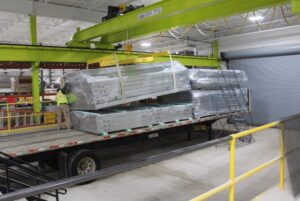The United States faces a severe housing shortage.
“Years of underbuilding has created a large deficit, particularly for states with strong economies that have attracted a lot of people from other states,” says the report, The Housing Supply Shortage: State of the States, from mortgage loan company Freddie Mac. “The issue of undersupply will be further exacerbated as Millennials and younger generations enter the housing markets.”
- Freddie Mac estimates that 2.5 million to 3.3 million additional homes are required to meet current needs
- The National Low Income Housing Coalition pegs the shortage of affordable homes nationally at 7.2 million
“To many, this may seem like a crisis, and in part they’re correct, but the housing shortage also presents an opportunity,” says The Tech Report. “It’s a chance for some of America’s great minds to demonstrate why this country is known for innovation, progress, and perseverance.”.
Google, Microsoft, many homebuilders and others believe modular homes, framed with steel, is the answer.
Some Modular Homes Use Steel for Structural Integrity
“While the U.S. housing shortage crisis won’t be solved overnight, modular homes point the way forward,” says The Tech Report.
- Google reportedly spent $30 million for 300 modular homes in the San Francisco Bay area
- Microsoft is reportedly spending $500 million for modular housing in the Seattle area
- Entekra, Blu Homes and Blokable are already using modular homebuilding techniques, while Connect Homes, which is led by a former Apple exec, has raised $27 million to do the same
Modular prefabricated homes are built in a factory to about 80% to 90% completion and then delivered to building sites for final assembly, according to Next Modular. Once completed, a modular home looks indistinguishable from a traditionally built home.
Although many builders construct modular homes with wood framing, some are turning to cold-formed steel (CFS) for its durability.
“The addition of light-gauge steel gives a modular house the structural integrity it needs to remain stable,” says the Tech Report.
Structural integrity is greatly needed in modular homes, as some can reach up to five stories and accommodate multiple families.

PDM Constructors’ prefabricated CFS-framed panels, delivered by truck, are helping to accelerate project timelines.
Multifamily Off-Site Construction: 75% of Your Workload by 2030
Kia Nejatian, real estate venture capitalist at Second Century Ventures, believes that prefabrication will be the preferred method for construction as cities around the world become increasingly populated, with regulatory requirements limiting construction site occupancy onsite for material storage.
Tom Hardiman, executive director at the Modular Building Institute, concurs that prefabrication will be more widely used in the future.
“I think in eight years, contractors and owners that are not embracing modular and off-site fabrication (prefabrication) as a significant portion of their business model are going to struggle to survive,” says Hardiman.
“By 2025, if a large contractor hasn’t embraced off-site construction for at least 25% of their workload, I wouldn’t expect that company to be in business by 2030,” Hardiman adds. “And if it’s a multifamily contractor, that figure needs to be closer to 50% to 75%.”
Cited from BuildSteel.org
